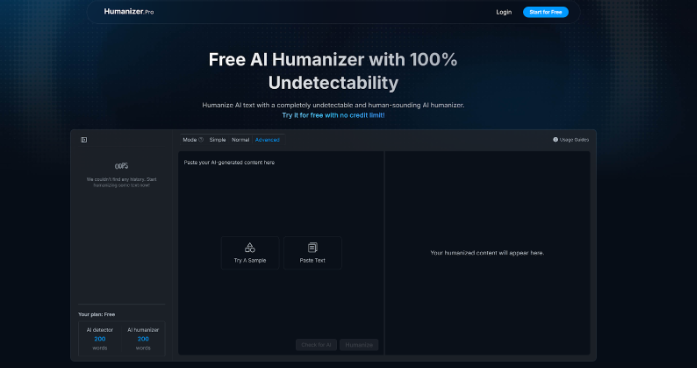Academic writing demands originality, nuance, and scholarly rigor. But let’s be real—sometimes, even with the best intentions, your AI-generated drafts (hello ChatGPT, Gemini, Claude) sound mechanical, repetitive, and way too obvious for university standards. Worse, schools are deploying heavy-duty AI detectors like Turnitin and GPTZero, meaning sloppy AI writing could tank your grades—or worse, get you flagged for misconduct.
If you want to use AI smartly without putting your academic integrity at risk, Humanizer.Pro is your secret weapon. This guide shows exactly how to humanize your AI drafts properly, create submission-worthy papers, and stay ahead of AI detection systems—all without dropping a dime.
How to Use Humanizer.Pro to Beat AI Detection
Step 1: Build a Solid AI Draft (Don’t Skip This)
Before you even touch Humanizer.Pro, you need a well-organized draft. Otherwise, polishing garbage still leaves you with garbage. Structure your AI-generated draft with classic academic sections.
Step 2: Process Your Text Through Humanizer.Pro
Access the Platform
- Head over to Humanizer.Pro.
- No login, no email signup, no hidden paywall nonsense.
Choose the Best Rewrite Mode
Humanizer.Pro gives you three levels of rewriting strength:
- Simple Mode: Light touch. Great for small edits or very short assignments.
- Normal Mode: Balanced transformation. Ideal for essays, reports, or thesis chapters.
- Advanced Mode: Heavy humanization. Perfect for dissertations, journal submissions, and anything facing hardcore scrutiny.
For serious academic writing, Advanced Mode is your best bet.
Process Your Draft
- Paste your AI draft into the text box.
- Select your desired mode.
- Click “Process.”
- In 5–10 seconds, you’ll get a humanized version ready for fine-tuning.
Refining Each Section for Academic Excellence
Humanizing the Literature Review
Literature reviews often get flagged because AI loves clichés like “many researchers agree” or “several studies show.” After running it through Humanizer.Pro:
- Replace bland transitions with specifics (e.g., “As evidenced by Johnson (2021) and Kim (2022)…”).
- Push critical analysis, not just summaries (“However, prior models fail to address…”).
Strengthening the Methodology Section
AI loves passive, lifeless descriptions. After humanizing:
- Mix active and passive voice smartly.
- Clarify technical processes and sample details.
- Make it sound deliberate, not robotic.
Enhancing the Discussion and Conclusion
AI-generated discussions often sound like dry summaries. Humanizer.Pro can inject actual analysis:
- Use comparative language (“in contrast to previous findings…”).
- Connect to theories or frameworks (“consistent with Vygotsky’s sociocultural theory…”).
- Highlight broader impacts (“this study’s findings extend existing knowledge about…”).
After Humanizing: Critical Quality Checks
 1. Citation Accuracy
1. Citation Accuracy
AI models are notoriously bad at citing properly. After humanizing:
- Double-check in-text references and bibliography.
- Use tools like Zotero, EndNote, or manual cross-verification.
- Ensure compliance with APA, MLA, Chicago, or whatever style guide your university demands.
2. Plagiarism Testing
Humanizer.Pro significantly reduces plagiarism risk, but don’t gamble. Run your humanized draft through:
- PlagScan (free trial available)
- Quetext
- DupliChecker
Catch accidental paraphrasing overlaps before they catch you.
3. AI Detection Testing
Before submitting, scan your paper using:
- GPTZero: Score how “human” your work sounds.
- Turnitin: If your institution offers access, take advantage.
- Originality.ai or Copyleaks: Extra safety layer for major submissions.
If flagged, rerun the problematic section through Advanced Mode and tweak phrasing manually.
Key Ethical Reminders for Academic Work
Use AI as a Drafting Tool, Not a Thinking Replacement
Your ideas, insights, and critiques must still come from you. AI (and humanizers) should only polish your work—not generate your intellectual arguments.
Check Your University’s AI Disclosure Policies
Some schools now require a statement if you used AI tools at any stage of writing. Don’t get blindsided—review your institution’s handbook or ask your advisor.
Keep Data and Findings Accurate
Humanizer.Pro is powerful, but it’s still rewriting text. If your draft contains precise data (e.g., p-values, sample sizes), consider protecting these numbers with brackets [like this] before processing, then verify after.
Final Submission Checklist
✅ Detection: 95%+ human score confirmed on AI checkers
✅ Citations: Accurate and formatted properly
✅ Grammar: Proofread manually or with Grammarly
✅ Structure: Headings, fonts, margins match university specs
✅ Ethics: Disclosed AI use if required by institution
Conclusion: Outsmarting Detection Without Sacrificing Quality
Using AI for academic drafting isn’t cheating—if you know how to refine it properly. Humanizer.Pro gives you a free, powerful way to take rough machine text and turn it into polished, credible academic work that flies under the radar of AI detectors and satisfies professors’ expectations.
Work smarter, not harder—and make sure your final submission reflects your voice, not a machine’s. Start using Humanizer.Pro today and level up your academic writing game without breaking the rules—or your budget.







